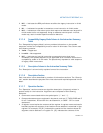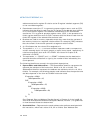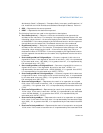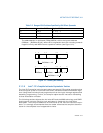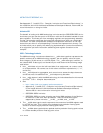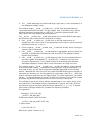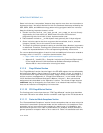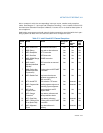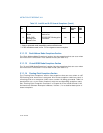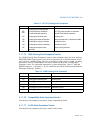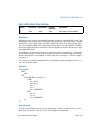
Vol. 2A 3-15
INSTRUCTION SET REFERENCE, A-M
letter mnemonic with the corresponding interrupt vector number and exception
name. See Chapter 5, “Interrupt and Exception Handling,” in the Intel® 64 and IA-32
Architectures Software Developer’s Manual, Volume 3A, for a detailed description of
the exceptions.
Application programmers should consult the documentation provided with their oper-
ating systems to determine the actions taken when exceptions occur.
Table 3-3. Intel 64 and IA-32 General Exceptions
Vector
No.
Name Source Protected
Mode
1
Real
Address
Mode
Virtual
8086
Mode
0#DE—Divide ErrorDIV and IDIV instructions. Yes Yes Yes
1 #DB—Debug Any code or data reference. Yes Yes Yes
3 #BP—Breakpoint INT 3 instruction. Yes Yes Yes
4 #OF—Overflow INTO instruction. Yes Yes Yes
5 #BR—BOUND Range
Exceeded
BOUND instruction. Yes Yes Yes
6#UD—Invalid
Opcode (Undefined
Opcode)
UD2 instruction or reserved
opcode.
Yes Yes Yes
7 #NM—Device Not
Available (No Math
Coprocessor)
Floating-point or WAIT/FWAIT
instruction.
Yes Yes Yes
8 #DF—Double Fault Any instruction that can
generate an exception, an
NMI, or an INTR.
Yes Yes Yes
10 #TS—Invalid TSS Task switch or TSS access. Yes Reserved Yes
11 #NP—Segment Not
Present
Loading segment registers or
accessing system segments.
Yes Reserved Yes
12 #SS—Stack
Segment Fault
Stack operations and SS
register loads.
Yes Yes Yes
13 #GP—General
Protection
2
Any memory reference and
other protection checks.
Yes Yes Yes
14 #PF—Page Fault Any memory reference. Yes Reserved Yes
16 #MF—Floating-Point
Error (Math Fault)
Floating-point or WAIT/FWAIT
instruction.
Yes Yes Yes
17 #AC—Alignment
Check
Any data reference in
memory.
Yes Reserved Yes



